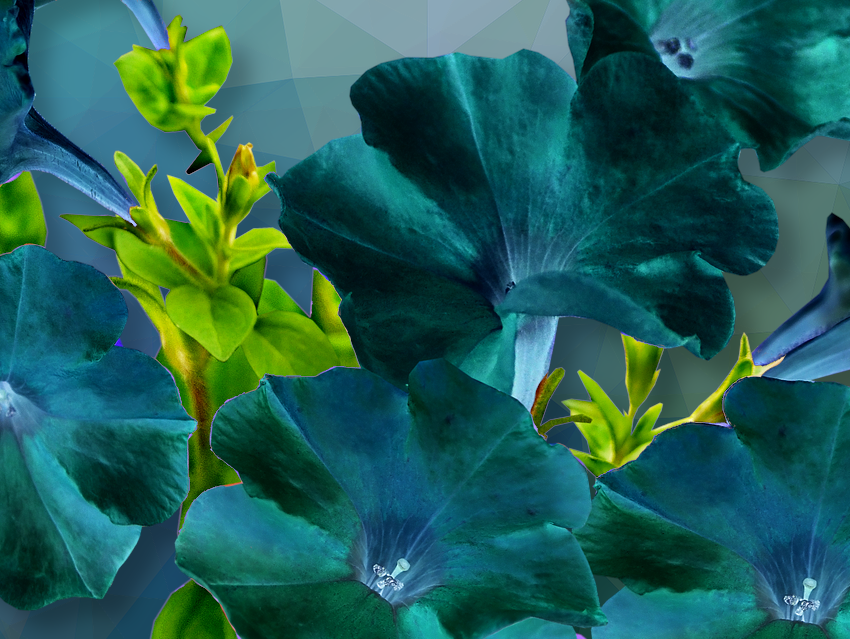A biotech company, Light Bio, has engineered petunias that contain genes from a bioluminescent mushroom (Neonothopanus nambi) to emit a continuous green glow. They plan to sell these glowing petunias (Petunia hybrida) for $29 in the U.S. starting in April 2024. The flowers appear white during the day and emit a faint green glow in the dark.
The fungus needs caffeic acid for its light-emitting reaction, a molecule also produced by terrestrial plants. By inserting the fungal genes into petunias, researchers enabled the plants to produce enzymes that convert caffeic acid into the light-emitting molecule luciferin and then recycle it back into caffeic acid. This process allows the plant to sustain the bioluminescent reaction without requiring specific light or food sources [1–3]. Three genes are sufficient to produce and recycle luciferin from caffeic acid, while a fourth fungal gene encodes luciferase, which oxidizes luciferin to produce visible photons.
The U.S. Department of Agriculture approved this petunia in September 2023 because it is not native to North America and is not considered invasive, minimizing the risk of spreading modified genes. [4]
- Light Bio Inc., Ketchum, ID, USA
[1] Tatiana Mitiouchkina, Alexander S. Mishin, Louisa Gonzalez Somermeyer, Nadezhda M. Markina, Tatiana V. Chepurnyh, Elena B. Guglya, Tatiana A. Karataeva, Kseniia A. Palkina, Ekaterina S. Shakhova, Liliia I. Fakhranurova, Sofia V. Chekova, Aleksandra S. Tsarkova, Yaroslav V. Golubev, Vadim V. Negrebetsky, Sergey A. Dolgushin, Pavel V. Shalaev, Dmitry Shlykov, Olesya A. Melnik, Victoria O. Shipunova, Sergey M. Deyev, Andrey I. Bubyrev, Alexander S. Pushin, Vladimir V. Choob, Sergey V. Dolgov, Fyodor A. Kondrashov, Ilia V. Yampolsky, Karen S. Sarkisyan, Plants with genetically encoded autoluminescence, Nature Biotechnol. 2020, 38, 944–946. https://doi.org/10.1038/s41587-020-0500-9
[2] Arjun Khakhar, Colby G. Starker, James C. Chamness, Nayoung Lee, Sydney Stokke, Cecily Wang, Ryan Swanson, Furva Rizvi, Takato Imaizumi, Daniel F. Voytas, Building customizable auto-luminescent luciferase-based reporters in plants, eLife 2020. https://doi.org/10.7554/eLife.52786
[3] Ekaterina S. Shakhova, Tatiana A. Karataeva, Nadezhda M. Markina, Tatiana Mitiouchkina, Kseniia A. Palkina, Maxim M. Perfilov, Monika G. Wood, Trish T. Hoang, Mary P. Hall, Liliia I. Fakhranurova, Anna E. Alekberova, Alena K. Malyshevskaia, Dmitry A. Gorbachev, Evgenia N. Bugaeva, Ludmila K. Pletneva, Vladislav V. Babenko, Daria I. Boldyreva, Andrey Y. Gorokhovatsky, Anastasia V. Balakireva, Feng Gao, Vladimir V. Choob, Lance P. Encell, Keith V. Wood, Ilia V. Yampolsky, Karen S. Sarkisyan, Alexander S. Mishin, An improved pathway for autonomous bioluminescence imaging in eukaryotes, Nature Methods 2024. https://doi.org/10.1038/s41592-023-02152-y
[4] APHIS Issues Regulatory Status Review Response: Light Bio Petunia, U.S. Department of Agriculture, September 6, 2023. (accessed February 22, 2024)




